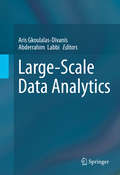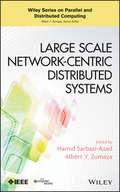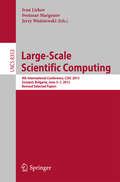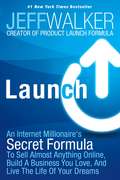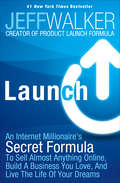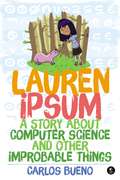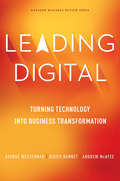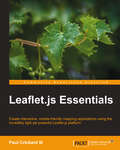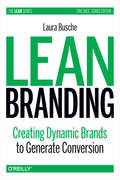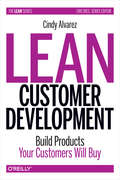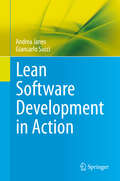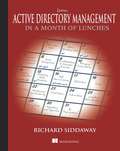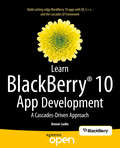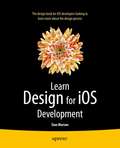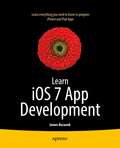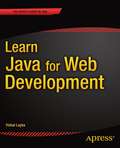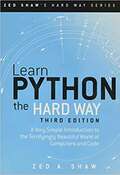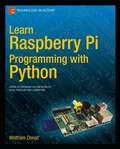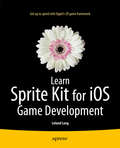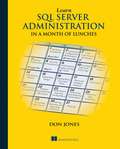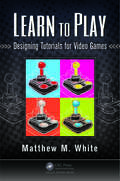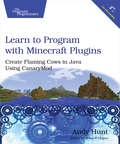- Table View
- List View
Large-Scale Data Analytics
by Aris Gkoulalas-Divanis Abderrahim LabbiThis edited book collects state-of-the-art research related to large-scale data analytics that has been accomplished over the last few years. This is among the first books devoted to this important area based on contributions from diverse scientific areas such as databases, data mining, supercomputing, hardware architecture, data visualization, statistics, and privacy. There is increasing need for new approaches and technologies that can analyze and synthesize very large amounts of data, in the order of petabytes, that are generated by massively distributed data sources. This requires new distributed architectures for data analysis. Additionally, the heterogeneity of such sources imposes significant challenges for the efficient analysis of the data under numerous constraints, including consistent data integration, data homogenization and scaling, privacy and security preservation. The authors also broaden reader understanding of emerging real-world applications in domains such as customer behavior modeling, graph mining, telecommunications, cyber-security, and social network analysis, all of which impose extra requirements for large-scale data analysis. Large-Scale Data Analytics is organized in 8 chapters, each providing a survey of an important direction of large-scale data analytics or individual results of the emerging research in the field. The book presents key recent research that will help shape the future of large-scale data analytics, leading the way to the design of new approaches and technologies that can analyze and synthesize very large amounts of heterogeneous data. Students, researchers, professionals and practitioners will find this book an authoritative and comprehensive resource.
Large Scale Network-Centric Distributed Systems
by Albert Y. Zomaya Hamid Sarbazi-AzadA highly accessible reference offering a broad range of topics and insights on large scale network-centric distributed systemsEvolving from the fields of high-performance computing and networking, large scale network-centric distributed systems continues to grow as one of the most important topics in computing and communication and many interdisciplinary areas. Dealing with both wired and wireless networks, this book focuses on the design and performance issues of such systems.Large Scale Network-Centric Distributed Systems provides in-depth coverage ranging from ground-level hardware issues (such as buffer organization, router delay, and flow control) to the high-level issues immediately concerning application or system users (including parallel programming, middleware, and OS support for such computing systems). Arranged in five parts, it explains and analyzes complex topics to an unprecedented degree:Part 1: Multicore and Many-Core (Mc) Systems-on-ChipPart 2: Pervasive/Ubiquitous Computing and Peer-to-Peer SystemsPart 3: Wireless/Mobile NetworksPart 4: Grid and Cloud ComputingPart 5: Other Topics Related to Network-Centric Computing and Its ApplicationsLarge Scale Network-Centric Distributed Systems is an incredibly useful resource for practitioners, postgraduate students, postdocs, and researchers.
Large-Scale Scientific Computing
by Ivan Lirkov Svetozar Margenov Jerzy WaśniewskiThis book constitutes the thoroughly refereed post-conference proceedings of the 9th International Conference on Large-Scale Scientific Computations, LSSC 2013, held in Sozopol, Bulgaria, in June 2013. The 74 revised full papers presented together with 5 plenary and invited papers were carefully reviewed and selected from numerous submissions. The papers are organized in topical sections on numerical modeling of fluids and structures; control and uncertain systems; Monte Carlo methods: theory, applications and distributed computing; theoretical and algorithmic advances in transport problems; applications of metaheuristics to large-scale problems; modeling and numerical simulation of processes in highly heterogeneous media; large-scale models: numerical methods, parallel computations and applications; numerical solvers on many-core systems; cloud and grid computing for resource-intensive scientific applications.
Lattice Coding for Signals and Networks
by Ram ZamirUnifying information theory and digital communication through the language of lattice codes, this book provides a detailed overview for students, researchers and industry practitioners. It covers classical work by leading researchers in the field of lattice codes and complementary work on dithered quantization and infinite constellations, and then introduces the more recent results on 'algebraic binning' for side-information problems, and linear/lattice codes for networks. It shows how high dimensional lattice codes can close the gap to the optimal information theoretic solution, including the characterisation of error exponents. The solutions presented are based on lattice codes, and are therefore close to practical implementations, with many advanced setups and techniques, such as shaping, entropy-coding, side-information and multi-terminal systems. Moreover, some of the network setups shown demonstrate how lattice codes are potentially more efficient than traditional random-coding solutions, for instance when generalising the framework to Gaussian networks.
Launch: An Internet Millionaire's Secret Formula to Sell Almost Anything Online, Build a Business You Love, and Live the Life of Your Dreams
by Jeff Walker<p>"Launch" will build your business---fast. Whether you’ve already got a business or you’re itching to start one, this is a recipe for getting more traction. <p>Think about it---what if you could launch like Apple or the big Hollywood studios? What if your prospects eagerly counted down the days until they could buy your product? What if you could create such powerful positioning in your market that you all -but- eliminated your competition? And you could do all that no matter how humble your business or budget? <p>Since 1996 Jeff Walker has been creating hugely successful online launches. After bootstrapping his first Internet business from his basement, he quickly developed an underground process for launching new products and businesses with unprecedented success. <p>But the success-train was just getting started---once he started teaching his formula to other entrepreneurs, the results were simply breathtaking. Tiny, home-based businesses started doing launches that sold tens of thousands, hundreds of thousands, and even millions of dollars in sales with their launches. <p>"Launch" is the treasure map into that world---an almost secret world of digital entrepreneurs who create cash-on-demand paydays with their product launches and business launches. <p>Whether you have an existing business, or you have a service-based business and want to develop your own products so you can leverage your time and your impact, or you're still in the planning phase---this is how you start fast. This formula is how you engineer massive success. <p>Now the question is this---are you going to start slow, and fade away from there? Or are you ready for a launch that will change the future of your business and your life?</p>
Launch: An Internet Millionaire's Secret Formula to Sell Almost Anything Online, Build a Business You Love, and Live the Life of Your Dreams
by Jeff Walker"Launch" will build your business---fast. Whether you've already got a business or you're itching to start one, this is a recipe for getting more traction.Think about it---what if you could launch like Apple or the big Hollywood studios? What if your prospects eagerly counted down the days until they could buy your product? What if you could create such powerful positioning in your market that you all -but- eliminated your competition? And you could do all that no matter how humble your business or budget?Since 1996 Jeff Walker has been creating hugely successful online launches. After bootstrapping his first Internet business from his basement, he quickly developed an underground process for launching new products and businesses with unprecedented success.But the success-train was just getting started---once he started teaching his formula to other entrepreneurs, the results were simply breathtaking. Tiny, home-based businesses started doing launches that sold tens of thousands, hundreds of thousands, and even millions of dollars in sales with their launches."Launch" is the treasure map into that world---an almost secret world of digital entrepreneurs who create cash-on-demand paydays with their product launches and business launches.Whether you have an existing business, or you have a service-based business and want to develop your own products so you can leverage your time and your impact, or you're still in the planning phase---this is how you start fast. This formula is how you engineer massive success.Now the question is this---are you going to start slow, and fade away from there? Or are you ready for a launch that will change the future of your business and your life?,
Lauren Ipsum: A Story About Computer Science and Other Improbable Things
by Carlos BuenoLauren Ipsum is a whimsical journey through a land where logic and computer science come to life.Meet Lauren, an adventurer lost in Userland who needs to find her way home by solving a series of puzzles. As she visits places like the Push & Pop Café and makes friends with people like Hugh Rustic and the Wandering Salesman, Lauren learns about computer science without even realizing it—and so do you!Read Lauren Ipsum yourself or with someone littler than you, then flip to the notes at the back of the book to learn more about logic and computer science in the real world.Suggested for ages 10+
Law of Electronic Commercial Transactions: Contemporary Issues in the EU, US and China (Routledge Research in Information Technology and E-Commerce Law)
by Faye Fangfei WangThe development of new technologies places new challenges to the interpretation and implementation of legislation in the information society. The recent deployment of service-oriented computing and cloud computing for online commercial activities has urged countries to amend existing legislation and launch new regulations. With the exponential growth of international electronic commercial transactions, a consistent global standard of regulating the legal effects of electronic communications, the protection of data privacy security and the effectiveness of Internet-related dispute resolution are motivating factors to build users’ trust and confidence in conducting cross-border business and their sharing information online. The second edition of this book continues taking a ‘solutions to obstacles’ approach and analyses the main legal obstacles to the establishment of trust and confidence in undertaking business online. In comparing the legislative frameworks of e-commerce in the EU, US, China and International Organisations, the book sets out solutions to modernise and harmonise laws at the national, regional and international levels in response to current technological developments. It specifically provides information on the key legal challenges caused by the increasing popularity of service-oriented computing and cloud computing as well as the growing number of cross-border transactions and its relation to data privacy protection, Internet jurisdiction, choice of law and online dispute resolution. It considers how greater legal certainty can be achieved in cloud computing service contracts and other agreements resulted in service-oriented computing. The second edition of Law of Electronic Commercial Transactions is a clear and up to date account of a fast-moving area of study. It will be of great value to legislators, politicians, practitioners, scholars, businesses, individuals, postgraduate and undergraduate students. It provides in-depth research into finding solutions to remove eight generic legal obstacles in electronic commercial transactions and offers insights into policy making, law reforms, regulatory developments and self-protection awareness.
Leading Digital: Turning Technology into Business Transformation
by George Westerman Didier Bonnet Andrew McafeeLeading Digital makes the provocative argument that the next imminent phase of digital technology adoption - driven by the convergence of mobility, analytics, social media, cloud computing, and embedded devices - will make everything that’s happened so far look like a prelude. The authors, a trio of highly regarded thought leaders on corporate digital transformation, say changes in the digital realm so far have focused on high tech and media companies - but there’s still a whopping 94% of the business economy that needs to change. This book will show them how. George Westerman of MIT, Didier Bonnet of Capgemini Consulting, and Andrew McAfee, also at MIT, say there is opportunity for these businesses to learn from those that have already mastered the digital landscape. Based on a study of more than 400 large, mainstream firms in every industry around the globe, the authors usefully break down how these organizations have used their own digital transformation to gain strategic, competitive advantage. Readers will learn how these digital leaders have transformed their businesses through smart and rigorous digital investments, and through smart and effective leadership of the change. Leading Digital offers practical, real-life tested frameworks that can be instantly applied. Case studies include Nike, Caesars, Burberry, Asian Paints, Pages Jaunes, Codelco, and more.
Leaflet.js Essentials
by Paul Crickard IIIIf you are a web developer working with geospatial concepts and mapping APIs, and you want to learn Leaflet to create mapping solutions, this book is for you. You need to have a basic knowledge of working with JavaScript and performing web application development.
Lean Branding: Creating Dynamic Brands to Generate Conversion (Lean (o'reilly) Ser.)
by Laura BuscheEvery day, thousands of passionate developers come up with new startup ideas but lack the branding know-how to make them thrive. If you count yourself among them, Lean Branding is here to help.This practical toolkit helps you build your own robust, dynamic brands that generate conversion. You'll find over 100 DIY branding tactics and inspiring case studies, and step-by-step instructions for building and measuring 25 essential brand strategy ingredients, from logo design to demo-day pitches, using The Lean Startup methodology's Build-Measure-Learn loop.Learn exactly what a brand is--and what it isn'tBuild a minimal set of brand ingredients that are viable in the marketplace: brand story, brand symbols, and brand strategyMeasure your brand ingredients by using meaningful metrics to see if they meet your conversion goalsPivot your brand ingredients in new directions based on what you've learned--by optimizing rather than trashingFocus specifically on brand story, symbols, or strategy by following the Build-Measure-Learn chapters that apply
Lean Customer Development
by Cindy AlvarezHow do you develop products that people will actually use and buy? This practical guide shows you how to validate product and company ideas through customer development research--before you waste months and millions on a product or service that no one needs or wants.With a combination of open-ended interviewing and fast and flexible research techniques, you'll learn how your prospective customers behave, the problems they need to solve, and what frustrates and delights them. These insights may shake your assumptions, but they'll help you reach the "ah-ha!" moments that inspire truly great products.Validate or invalidate your hypothesis by talking to the right peopleLearn how to conduct successful customer interviews play-by-playDetect a customer's behaviors, pain points, and constraintsTurn interview insights into Minimum Viable Products to validate what customers will use and buyAdapt customer development strategies for large companies, conservative industries, and existing products
Lean Customer Development: Building Products Your Customers Will Buy
by Cindy AlvarezHow do you develop products that people will actually use and buy? This practical guide shows you how to validate product and company ideas through customer development research—before you waste months and millions on a product or service that no one needs or wants.With a combination of open-ended interviewing and fast and flexible research techniques, you’ll learn how your prospective customers behave, the problems they need to solve, and what frustrates and delights them. These insights may shake your assumptions, but they’ll help you reach the "ah-ha!" moments that inspire truly great products.Validate or invalidate your hypothesis by talking to the right peopleLearn how to conduct successful customer interviews play-by-playDetect a customer’s behaviors, pain points, and constraintsTurn interview insights into Minimum Viable Products to validate what customers will use and buyAdapt customer development strategies for large companies, conservative industries, and existing products
Lean Software Development in Action
by Andrea Janes Giancarlo SucciThis book illustrates how goal-oriented, automated measurement can be used to create Lean organizations and to facilitate the development of Lean software, while also demonstrating the practical implementation of Lean software development by combining tried and trusted tools. In order to be successful, a Lean orientation of software development has to go hand in hand with a company's overall business strategy. To achieve this, two interrelated aspects require special attention: measurement and experience management. In this book, Janes and Succi provide the necessary knowledge to establish "Lean software company thinking," while also exploiting the latest approaches to software measurement. A comprehensive, company-wide measurement approach is exactly what companies need in order to align their activities to the demands of their stakeholders, to their business strategy, etc. With the automatic, non-invasive measurement approach proposed in this book, even small and medium-sized enterprises that do not have the resources to introduce heavyweight processes will be able to make their software development processes considerably more Lean. The book is divided into three parts. Part I, "Motivation for Lean Software Development," explains just what "Lean Production" means, why it can be advantageous to apply Lean concepts to software engineering, and which existing approaches are best suited to achieving this. Part II, "The Pillars of Lean Software Development," presents the tools needed to achieve Lean software development: Non-invasive Measurement, the Goal Question Metric approach, and the Experience Factory. Finally, Part III, "Lean Software Development in Action," shows how different tools can be combined to enable Lean Thinking in software development. The book primarily addresses the needs of all those working in the field of software engineering who want to understand how to establish an efficient and effective software development process. This group includes developers, managers, and students pursuing an M. Sc. degree in software engineering.
Learn Active Directory Management in a Month of Lunches
by Richard SiddawaySummaryLearn Active Directory Management in a Month of Lunches is a practical, hands-on tutorial designed for IT pros new to Active Directory. It skips the theory and concentrates on the day-to-day administration tasks you need to know to keep your network running smoothly. Just set aside an hour a day for a month—lunchtime would be perfect—and you'll be comfortable and productive with Active Directory before you know it.About the BookAt the heart of your Windows network is Active Directory, the control center for administration, security, and other core management functions. If you're new to Active Directory administration—or if you find yourself unexpectedly thrust into that role—you'll need to get up to speed fast.Learn Active Directory Management in a Month of Lunches is a hands-on tutorial designed for IT pros new to Active Directory. Without assuming previous administration experience, the book starts by walking you through the most important day-to-day system management tasks. You'll learn how to administer AD both from the GUI tools built into Windows and by using PowerShell at the command line. Along the way, you'll touch on best practices for managing user access, setting group policies, automating backups, and more.This book assumes no prior experience with Active Directory or Windows administration. Examples are based in Windows Server 2012Purchase of the print book includes a free eBook in PDF, Kindle, and ePub formats from Manning Publications.What's InsideADM tasks you'll need every dayGUI and command line techniquesContent tested by new administratorsWell-illustrated, clearly explained examplesAbout the AuthorRichard Siddaway is an experienced all-around Windows administrator with two decades of experience. He's the author of PowerShell in Practice andPowerShell and WMI, and coauthor of PowerShell in Depth.Table of ContentsPART 1 MANAGING ACTIVE DIRECTORY DATABefore you beginCreating user accountsManaging user accountsManaging groupsTroubleshooting users and groupsManaging computer accountsManaging organizational unitsPART 2 MANAGING GROUP POLICYCreating Group PoliciesManaging Group PoliciesFine-grained password policiesPART 3 MANAGING THE ACTIVE DIRECTORY SERVICECreating domain controllersManaging domain controllersProtecting AD data Security: Default groups and delegationManaging DNSManaging sites and subnetsAD replicationManaging AD trustsPART 4 MAINTENANCE AND TROUBLESHOOTINGTroubleshooting your AD Maintaining and monitoring Active DirectoryFuture work and final examInto the cloud
Learn BlackBerry 10 App Development: A Cascades-Driven Approach
by Anwar LudinLearn how to leverage the BlackBerry 10 Cascades framework to create rich native applications. Learn BlackBerry 10 App Development gives you a solid foundation for creating BlackBerry 10 apps efficiently. Along the way, you will learn how to use QML and JavaScript for designing your app's UI, and C++/Qt for the application logic. No prior knowledge of C++ is assumed and the book covers the fundamental aspects of the language for writing BlackBerry 10 apps. Also a particular emphasis is put on how to create a visually enticing user experience with the Cascades framework, which is based on Qt and QML. Starting with the native SDK configuration and an overview of the Momentics IDE, the book is fast-paced and you will rapidly learn many of the best practices and techniques required for developing beautiful BlackBerry 10 apps. Learn BlackBerry 10 App Development is written for developers wishing to learn how to write apps for the new BlackBerry 10 OS and those interested in porting existing iOS and Android apps to BlackBerry 10 as native applications. What you'll learn * How to design and create native BB10 applications using the declarative expressiveness of QML * How to master the Cascades framework and the core BB10 UI components * How to use C++ and Qt efficiently with Cascades * How to utilize the BlackBerry Momentics IDE to launch and debug your applications * How to apply the fundamental aspects and best practices of BB10 application design * How to use HTTP networking in order to leverage remote services * How to integrate your application with BlackBerry 10 core apps such as the Contacts and Calendar apps * How to send email and short text messages from your app * How to use your device's camera and sensors such as the accelerometer and gyroscope Who this book is for BlackBerry developers wishing to write native BB10 applications, game developers. iOS and Android developers wishing to port their apps to BB 10. Table of Contents Getting Started QML & JavaScript C++, Qt and Cascades Controls Application Structure ListView and DataModel HTTP Networking Personal Information Management APIs Sensors Invocation Framework Device File System
Learn Design for iOS Development
by Sian MorsonLearn Design for iOS Development is for you if you're an iOS developer and you want to design your own apps to look great and be in tune with the latest Apple guidelines. You'll learn how to design your apps to work with the exciting new iOS 7 look and feel, which your users expect within their latest apps. Learn Design for iOS Development guides you through the design processes that you can apply to design your own apps brilliantly. We'll start at the idea stages of your apps, and you'll see how you can analyze and apply the right design patterns for every app you are coding, use wireframing tools to take your ideas forward, and use Photoshop to create the visual assets you want to look great in your app. You'll understand why Apple have made the decisions they've made with the new iOS 7 interface and new HIG guidelines, and from that insight you'll be able to vision and create your own apps, on iPhones and iPads, that work perfectly within the new iOS 7 interface. What you'll learn How to build apps that work within the exciting new iOS 7 design paradigm How to design great looking apps that your users will find a pleasure to use The deeper design elements you can apply to your apps What is and how to use Apple's Human Interface Guidelines (HIG) How to go beyond Apple's HIG guidelines to create innovative apps Design pattern basics and how you can use them How to use wireframes to create your app How to use Adobe Photoshop to create the visual assets for your apps How to create your app's icon and additional graphics for the App Store Extra considerations for iPad app design considerations Common design best practices and mistakes Who this book is for This book is for iOS developers who know that they can code well, but want to know how they can build apps to also have brilliant designs. This book is also a guide for all iOS app developers who want their apps to look contemporary within the new iOS 7 interface guidelines. Table of Contents 1. You've Got an Idea for an iPhone App, Now What? 2. iOS: What You Need to Know 3. iOS 7 and Flat Design 4. Getting to Know the User Interface of the iPhone and iPad Design Considerations 5. Mobile Design Patterns 6. Using Wireframes to Design Your App 7. Designing Your Visual Assets with Adobe Photoshop 8. Creating Your App Icon and Additional Graphics for the App Store 9. Finalizing Your Assets for App Development 10. Design Best Practices and Mistakes to Avoid
Learn iOS 8 App Development
by James BucanekLearn iOS 8 App Development is both a rapid tutorial and a useful reference. You'll quickly get up to speed with Swift, Cocoa Touch, and the iOS 8 SDK. It's an all-in-one getting started guide to building useful apps. You'll learn best practices that ensure your code will be efficient and perform well, earning positive reviews on the iTunes App Store, and driving better search results and more revenue. The iOS 8 SDK offers powerful new features, and this book is the fastest path to mastering them--and the rest of the iOS SDK --for programmers with some experience who are new to iPhone and iPad app development. Many books introduce the iOS SDK, but few explain how to develop apps optimally and soundly. This book teaches both core Swift language concepts and how to exploit design patterns and logic with the iOS SDK, based on Swift and the Cocoa Touch framework. Why spend months or years discovering the best ways to design and code iPhone and iPad apps when this book will show you how to do things the right way from the start? Get an accelerated treatment of the core fundamentals of Swift. Develop your first app using Xcode's advanced interface design tools. Build your first iPhone app using the code that you're given as you walk through this book. Finally, debug and distribute your first app on Apple's iTunes App Store. Learn how to create apps for any model of iPhone, the iPod Touch, the iPad, or build universal apps that run on all of them. After reading this book, you'll be creating professional quality apps, ready to upload to the app store, making you the prestige and the money you seek
Learn Java for Web Development
by Vishal LaykaWeb development is still one of today's most popular, active, and important programming and development activities. From a single web page to an e-commerce-enabled web site to a fully-fledged web application, the Java programming language and its frameworks allow you great flexibility and productivity for your web application development. Learn Java for Web Development teaches web developers who are new to Java key skills, Java-based languages, and frameworks to build simple or complex web sites and applications. As soon as you pick up this book, Vishal Layka's experience guides you on a very practical learning and building journey. You will learn the Java nuts and bolts necessary to build a simple "HelloWorld" Java (native) application, as well as a "HelloWorld" Java-based web application example that utilizes servlets and Java Server Pages (JSPs). Over the course of the book, you'll learn more about servlets and JSPs and delve into Java Server Faces (JSFs) and the expression language found in each of these by applying them in a real-world case study--a book store e-commerce application. Then you'll build your web application using Apache Struts2 and the Spring MVC framework. The book concludes by exploring the web application that you've built and examining industry best practices and how these might fit with your application, as well as covering alternative Java Web frameworks like Groovy/Grails and Scala/Play 2. You also can explore the basics of Java, Groovy, and Scala in the book's appendices. While reading this book, you'll see all this in action and you can use it as a starting point for further Java web development. Study and experiment with the many source code examples, and later apply them to your own web application building endeavors and 2:00 AM challenges. What you'll learn How to build your first Java-based web applications with servlets and JSPs How to apply best practices to web application development How to build web applications with JSF 2 How to build web applications with the Struts2 framework How to build web applications with the Spring 3 Web MVC framework How to build web applications with Grails and Play 2 How to debug and deploy your web application along the way Who this book is for This book is for current or aspiring web developers who have some programming experience, but have no or little prior experience using the Java programming language and the available frameworks for Java in web development. Table of Contents 1. Introducing Java Web Development 2. Building Applications with Servlets and JSP 3. Best Practices in Java EE Web Development 4. Building Applications with Struts2 5. Building Applications with Spring Web MVC 6. Building Applications with JSF 7. Rapid Web Development with Grails 8. Play with Java and Scala Appendix A. Introduction to Java Appendix B. Introduction to Groovy Appendix C. Introduction to Scala
Learn Python the Hard Way: A Very Simple Introduction to the Terrifyingly Beautiful World of Computers and Code
by Zed ShawZed Shaw has perfected the world's best system for learning Python. Follow it and you will succeed-just like the hundreds of thousands of beginners Zed has taught to date! You bring the discipline, commitment, and persistence; the author supplies everything else. <p><p> In Learn Python the Hard Way, Third Edition, you'll learn Python by working through 52 brilliantly crafted exercises. Read them. Type their code precisely. (No copying and pasting!) Fix your mistakes. Watch the programs run. As you do, you'll learn how software works; what good programs look like; how to read, write, and think about code; and how to find and fix your mistakes using tricks professional programmers use. Most importantly, you'll learn the following, which you need to start writing excellent Python software of your own.
Learn Raspberry Pi Programming with Python
by Wolfram DonatLearn Raspberry Pi Programming with Python will show you how to program your nifty new $35 computer to make a web spider, a weather station, a media server, and more. You'll learn how to program in Python on your Raspberry Pi with hands-on examples and fun projects. Even if you're completely new to programming in general, you'll figure out how to create a home security system, an underwater photography system, an RC plane with a camera, and even a near-space weather balloon with a camera. You'll learn how to make a variety of fun and even useful projects, from a web bot to search and download files to a toy to drive your pets insane. You'll even learn how to use Pi with Arduino as well as Pi with Gertboard, an expansion board with an onboard ATmega microcontroller. What you'll learn Raspberry Pi and electronics basics Quick intro to Linux Python basics to get you started on a set of projects How to make a variety of Pi and Python projects, including servers and gadgets with cameras How to use Pi with Arduino and Gertboard Who this book is for Readers who want to learn Python on a fun platform like the Pi and pick up some electronics skills along the way. No programming or Linux skill required, but a little experience with Linux will be helpful. Table of Contents1. Introducing the Raspberry Pi2. Linux by the Seat of Your Pants3. Introducing Python4. Electronics at 100mph5. The WebBot6. The Weather Station7. The Media Server8. The Home Security System9. The Cat Toy10. The Radio-controlled Airplane11. The Weather Balloon12. The Submersible13. The Gertboard14. The Raspberry Pi and the Arduino"
Learn Sprite Kit for iOS Game Development
by Leland LongWith Learn Sprite Kit for iOS Game Development, you'll discover how easy it is to create 2D games using the new Sprite Kit framework from Apple. You'll find how simple it is to create a scene, add animated sprites, incorporate edges, play sound effects, and create animated particles for special effects. You'll also use touch events to control your sprites, implement the built-in physics engine, handle sprite collisions and contacts, and much more. To help you in learning how to use all these cool features of Sprite Kit, you'll follow along as we build a complete 2D game for iPhone. By the time you finish the book, you'll have made your own 2D game, and you'll have learned all you need to know to get started on your next masterpiece. What you'll learn How to add animated sprites to your game scene Using TouchEvents to have your sprite react to touch input How to apply realistic physics to your game scene and characters Handling sprite collisions and contacts with other game elements Adding game logic for sprite interaction, scoring, levels, and more Adding a second player and using GameKit Who this book is for Beginning developers who have some understanding of object-oriented programming as well as intermediate iOS developers who want to get up to speed quickly with Sprite Kit. Table of Contents 1. Hello World 2. SKActions and SKTexture: Your First Animated Sprite 3. Sprite Movement with User Input 4. Edges, Boundaries, and Ledges 5. More Animated Sprites: Enemies and Bonuses 6. Creating a Cast of Characters 7. Points and Scoring 8. Contacts and Collisions 9. Adding More Scenes and Levels 10. Where to Go from Here
Learn SQL Server Administration in a Month of Lunches
by Don JonesSummaryLearn SQL Server Administration in a Month of Lunches is the perfect way to get started with SQL Server operations, including maintenance, backup and recovery, high availability, and performance monitoring. In about an hour a day over a month, you'll learn exactly what you can do, and what you shouldn't touch. Most importantly, you'll learn the day-to-day tasks and techniques you need to keep SQL Server humming along smoothly.Purchase of the print book includes a free eBook in PDF, Kindle, and ePub formats from Manning Publications.About the BookMicrosoft SQL Server is used by millions of businesses, ranging in size from Fortune 500s to small shops worldwide. Whether you're just getting started as a DBA, supporting a SQL Server-driven application, or you've been drafted by your office as the SQL Server admin, you do not need a thousand-page book to get up and running.Learn SQL Server Administration in a Month of Lunches is the perfect way to get started with SQL Server. This concise, easy-to-read book skips academic introductions and teaches you day-to-day techniques for maintenance, backup and recovery, performance monitoring, and more. Each of the 21 short lessons gives you practical takeaways you'll use over and over.What's InsideMaster the basics—indexes, logins, backup, recovery ... and moreLearn what you can and cannot do when supporting a third-party applicationMonitor and improve performanceWritten by expert trainer and bestselling author Don JonesAccessible to readers of any level of experience, the book covers techniques for all versions of SQLServer 2005-2014. About the AuthorDon Jones is a Microsoft MVP, speaker, and trainer. He is the creator of the Month of Lunches series and author of over 50 books on PowerShell, IIS, Active Directory, SCCM, SQL Server, and more.Table of ContentsBefore you beginServer assessment and configurationT-SQL crash courseManaging databasesBackup and recoveryAuthentication: who are you? Authorization: what are you allowed to do? Accounting: what did you do?Analyzing indexesMaintaining indexesTuning index designsReading query execution plansBlock and deadlock analysisAutomating management with SQL Server AgentMultiserver managementWindows PowerShell and SQL ServerUsing Extended EventsMonitoring and analyzing performanceOptions for high availabilityVirtualizing SQL ServerMoving, migrating, and upgrading databasesSQL Server performance checklistNever the end
Learn to Play: Designing Tutorials for Video Games
by Matthew M. WhiteSee How to Unobtrusively Incorporate Good Teaching into Your Game's MechanicsLearn to Play: Designing Tutorials for Video Games shows how to embed a tutorial directly into your game design mechanics so that your games naturally and comfortably teach players to have fun. The author deciphers years of research in game studies, education, psychology,
Learn to Program with Minecraft Plugins: Create Flaming Cows in Java Using CanaryMod
by Andy HuntThe first edition of this book used the Bukkit modding server and library, which was taken down due to a legal dispute in September 2014. This new edition has been completely revised to replace Bukkit with the CanaryMod library.The bestselling, kid-tested book for Minecraft is now updated for CanaryMod! Write your own Minecraft plugins and watch your code come to life with flaming cows, flying creepers, teleportation, and interactivity. Add your own features to the Minecraft game by developing Java code that "plugs in" to the server. You'll manipulate and control elements in the 3D graphical game environment without having to write tons of code or learn huge frameworks. No previous programming experience necessary.Expand your Minecraft experience! You'll learn how to write Java code and build plugins for your own Minecraft servers using the popular Java programming language. This new edition has been completely revised to use the freely-available CanaryMod library.You'll create plugins that can change blocks from air to stone, or spawn cows and creepers. You'll write plugins that react to game events, and even schedule tasks that will run later in the game. Readers from age 9 to 99 will learn how to use variables and functions to build plugins that fling players into the sky, create flying creepers, and of course, shoot flaming cows.Along the way you'll learn real programming using Java, from classes, objects, and data structures (including arrays and hashes) to exception handling and threads. You'll even learn how to back up your code (and go back in time!) using Git, and run your own server at home or in the cloud. A progress bar shows you how far you've come in each chapter, and by the end of the book you'll be able to design and code your own plugins.Put your gaming to good use, and learn real programming skills today.What You Need:A modern PC running the Windows, Mac OS X, or Linux operating systems. The book explains how to download Java, the CanaryMod server and API, and all the tools you'll need.
